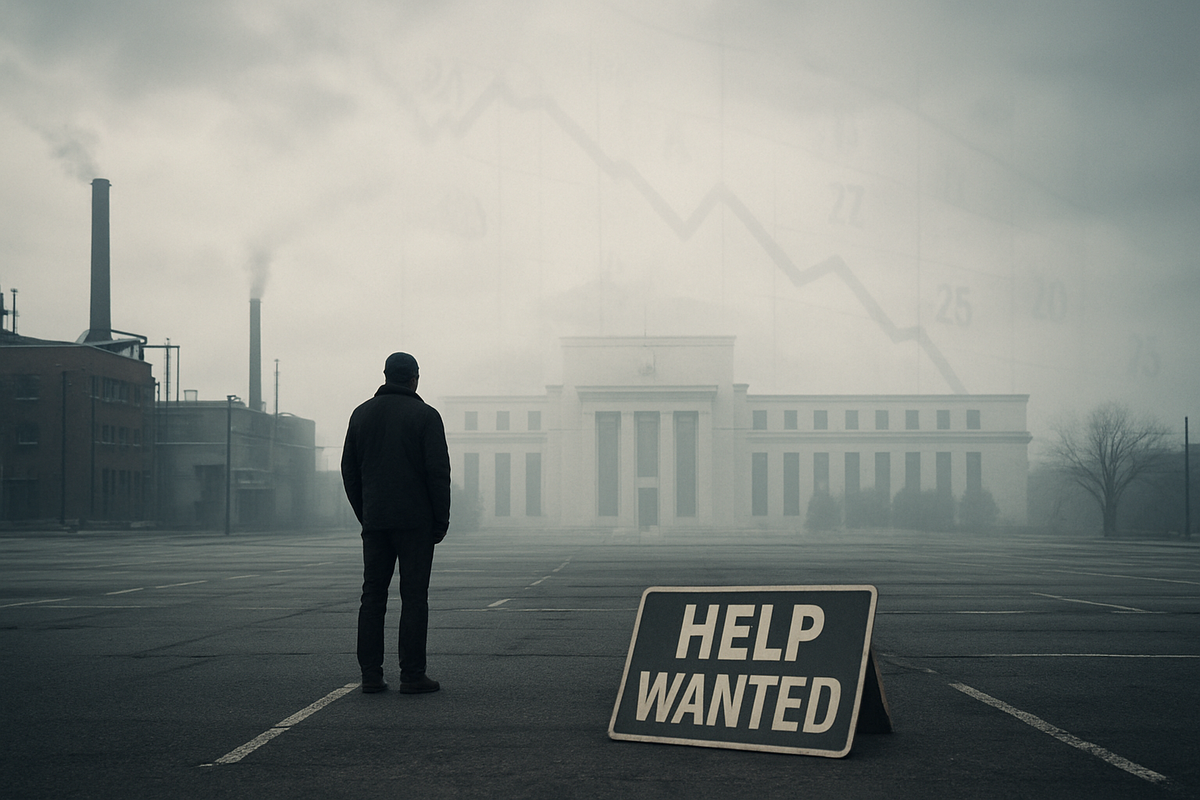
The economic outlook for the U.S. Midwest has taken a concerning turn as the Chicago Federal Reserve's 7th District hiring expectations index reportedly plummeted to -40 in October 2025. This alarming figure represents the lowest reading for hiring expectations since the tumultuous year of 2020 and, excluding the pandemic anomaly, the weakest result since the survey's inception in 2013. The dramatic drop signals a widespread and profound pessimism among businesses in the region regarding future employment, with immediate implications for the broader U.S. economy and the Federal Reserve's delicate balancing act.
This sharp deterioration in hiring sentiment from a key industrial and agricultural heartland suggests that businesses anticipate either reducing their workforces or severely curtailing new hires. Such a development directly impacts the Federal Reserve's dual mandate of achieving maximum employment and price stability. Financial markets are likely to interpret this as a reinforcement of bets on an "easier Fed path," potentially accelerating expectations for further interest rate cuts to stimulate economic activity and avert a deeper downturn, even as persistent inflation remains a concern.
Unpacking the Collapse: Details, Timeline, and Reactions
The Chicago Federal Reserve's 7th District, encompassing most of Illinois, Indiana, Iowa, Michigan, and Wisconsin, reported this significant downturn in hiring expectations for October 2025. The Hiring Expectations index, a component of the Chicago Fed Survey of Economic Conditions (CFSEC), crashed to -40, a substantial fall that underscores a rapid and severe shift in business sentiment. This index is a diffusion index where negative values indicate a pessimistic outlook, meaning more respondents anticipate below-average hiring growth than above-average. The "current hiring index" has also reportedly been negative for three consecutive years, indicating a prolonged period of deteriorating sentiment, culminating in this acute drop.
The specific report indicating the -40 hiring expectations index was for October 2025, although a precise release date within October isn't provided. The sharp 41-point drop within just two months prior to October highlights the accelerated pace of this negative shift. This sudden decline contrasts with previous periods, indicating a rapid change in the economic landscape. Key players involved include the Chicago Federal Reserve, which conducts the survey; the businesses in the 7th District whose collective outlook forms the basis of the index; and the broader Federal Reserve System, including the Board of Governors and the Federal Open Market Committee (FOMC), which utilizes these regional reports to inform national monetary policy decisions.
This -40 reading is particularly significant as it marks the lowest point since April 2020, during the initial phase of the COVID-19 pandemic. Excluding that anomalous period, it represents the weakest outlook since the survey began in 2013, indicating a fundamental and concerning shift in hiring sentiment beyond crisis-level events. Initial market reactions reflect heightened expectations for a more accommodative stance from the Federal Reserve. Traders are closely monitoring this data for potential implications on the Fed's interest rate path, with some anticipating further rate cuts. This weakness in the labor market can also lead to increased volatility in stock and cryptocurrency markets, as investors reassess risk in response to potential economic slowdowns.
Corporate Crossroads: Winners and Losers in a Slowing Economy
The dramatic slowdown in hiring signaled by the Chicago Fed's report, coupled with the potential for further Federal Reserve interest rate cuts, will inevitably reshape the fortunes of public companies, particularly those with significant exposure to the 7th District's diverse economy. The region is characterized by strong manufacturing, agriculture, and financial sectors, making its economic health a bellwether for many industries.
Potential Losers:
- Manufacturing (especially Automotive and Transportation Equipment): This sector, a cornerstone of the 7th District, is particularly vulnerable. Companies like Caterpillar (NYSE: CAT), which maintains a significant presence in the O'Hare area, and numerous automotive suppliers across Michigan, Indiana, and Illinois, could face reduced demand for big-ticket items and industrial machinery. A hiring slowdown directly impacts production volumes, potentially leading to underutilization of capacity and increased unit costs. While lower interest rates might eventually stimulate equipment upgrades, the immediate hiring crash suggests deeper demand issues.
- Retail and Consumer Discretionary: With reduced consumer confidence and spending due to job market uncertainty, retailers and companies offering non-essential goods and services will suffer. This could affect general merchandise retailers, restaurants, and leisure services with significant physical footprints in the District.
- Staffing and Recruitment Agencies: A hiring slowdown directly translates to less business for firms in this sector, as evidenced by reports of continued declines in demand from manufacturers for employment placement agencies.
- Commercial Real Estate Developers and Services: Firms like Chicago-based JLL (NYSE: JLL) could see slower demand for new commercial projects and leasing, although lower interest rates might eventually make financing more attractive for developers.
Potential Winners (or more resilient):
- Consumer Staples: Companies providing essential goods tend to be more resilient during economic downturns. Firms like The Kraft Heinz Company (NASDAQ: KHC) and Mondelez International (NASDAQ: MDLZ), both with significant presences in Chicago, may see stable demand for their products. Their operational costs might benefit from lower overall wage pressure, and lower interest rates could marginally reduce borrowing costs.
- Healthcare and Pharmaceuticals: The healthcare sector often exhibits defensive characteristics. Companies like AbbVie (NYSE: ABBV) and Abbott Laboratories (NYSE: ABT), with strong presences in the Chicago area, provide essential medical products and services, making them less susceptible to economic downturns. Lower interest rates could reduce the cost of financing R&D or capital expenditures.
- Utilities: Demand for utility services remains relatively constant. Companies like Exelon (NASDAQ: EXC), a major energy provider in the District, would likely maintain stable revenue streams. Their operational costs are more influenced by fuel prices and regulatory frameworks than by hiring fluctuations.
- Agriculture: Companies supporting the agricultural sector, such as agricultural processors like Archer Daniels Midland (ADM) (NYSE: ADM) in Chicago, might see varied impacts. Lower interest rates could benefit farmers by reducing borrowing costs for equipment and land, potentially stabilizing demand for agricultural inputs and machinery in the long term.
Should the Federal Reserve respond with further interest rate cuts, capital-intensive industries like manufacturing and real estate could benefit from cheaper financing, potentially alleviating some pressure on companies like Caterpillar. Companies with high variable-rate debt would also see reduced interest expenses. However, banks and financial institutions, particularly regional banks in the 7th District, might face pressure on their net interest margins due to lower rates.
Broader Significance: A National Ripple Effect
The Chicago Fed's 7th District hiring expectations crashing to -40 is not an isolated event; it aligns with and underscores a broader, concerning trend of a weakening labor market and increased economic uncertainty across the United States in late 2025. This regional signal acts as a potent indicator of nationwide deceleration.
Broader Industry Trends: U.S. job growth has moderated considerably throughout 2025, with year-over-year payroll growth estimated at a mere 0.5% in October, a sharp decline from earlier in the year. Layoffs have surged, reaching levels typically seen in recessions, with 1.1 million job cuts announced through October 2025, comparable to 2008 and 2009. Private sector employers' announced hiring plans reached their lowest number since 2009 in October 2025, reflecting a "wait and see" approach. The manufacturing sector, crucial to the 7th District, faces ongoing challenges including elevated costs and supply chain disruptions, with manufacturing jobs dropping by 78,000 over the year.
Ripple Effects: A significant downturn in a major economic region like the Chicago Fed's 7th District can generate widespread ripple effects. Reduced hiring and production in this manufacturing hub could impact national supply chains, leading to decreased availability of goods or delayed deliveries for businesses nationwide. Weakening labor markets and job insecurity directly impact consumer confidence and spending, which can depress demand for goods and services across the country. This risk to consumer spending is considered a meaningful downside to current GDP estimates for 2025. Furthermore, evidence of a weakening labor market fuels recession fears, which can lead to increased volatility in financial markets.
Regulatory and Policy Implications: This data, combined with national trends, presents significant policy challenges for the Federal Reserve. The Fed has already implemented two interest rate cuts in September and October 2025, lowering the federal funds rate to a target range of 3.75-4.00%. These cuts represent a shift towards supporting employment, even while inflation remains somewhat elevated. Further rate reductions are anticipated if labor market weakness persists or deepens, potentially signaling a more aggressive easing cycle. The Fed is caught between its dual mandate of maximum employment and stable prices, facing a challenging balancing act. Beyond monetary policy, a significant economic slowdown could prompt discussions about fiscal responses, such as government stimulus packages, although ongoing policy uncertainty and a federal government shutdown complicate these efforts. New U.S. trade policies and tariffs are also a dominant narrative, contributing to persistent inflation and reduced global growth forecasts.
Historical Precedents: The current level of layoffs is on par with those seen during the 2008 and 2009 Great Recession. Periods of sharply declining hiring expectations and rising unemployment have historically preceded or coincided with recessions, with the Fed typically cutting rates to stimulate growth. The ongoing debate about a "soft landing" versus a "recession" is a recurring theme, with increasing probabilities of recession cited by major banks. As of November 10, 2025, the overarching economic narrative is one of heightened uncertainty and a precarious balancing act, further exacerbated by the ongoing federal government shutdown and persistent inflation.
The Path Ahead: Scenarios and Strategic Responses
The confluence of crashing hiring expectations in the Chicago Fed's 7th District, a prolonged federal government shutdown, and persistent inflation creates an exceptionally challenging and uncertain economic outlook for November 2025 and beyond. Businesses and policymakers face a critical need for agile adaptation and strategic decision-making.
Short-Term Possibilities (Next 6-12 Months): The deeply negative Chicago Fed hiring expectations, alongside national job cut data, suggest an acceleration of labor market weakening, potentially leading to rising unemployment, slower wage growth, and reduced consumer spending. The prolonged government shutdown further erodes consumer confidence and spending, risking a sharper slowdown in consumer-driven economic activity and even a mild recession in early 2026. Market volatility is likely to remain high due to data blackouts and policy uncertainty.
Long-Term Possibilities (Beyond 12 Months): Beyond cyclical downturns, structural shifts in labor supply due to declining immigration and the increasing integration of AI could lead to job displacement and a persistently higher "natural" rate of unemployment. Persistent tariffs and geopolitical tensions are driving companies to diversify supply chains, potentially leading to higher long-term costs but also increased resilience. The economic costs of the shutdown will exacerbate the U.S. government debt load, potentially driving future inflation. However, AI-driven business investment could provide a long-term boost to productivity.
Strategic Pivots and Adaptations:
- For Businesses: Prioritize strengthening financial resilience, diversifying and localizing supply chains, implementing rigorous cost management and operational efficiency through automation and AI, focusing on customer retention, and embracing digital transformation to leverage data for better decision-making.
- For Policymakers: The immediate priority is resolving the federal government shutdown to restore economic activity and data flow. Targeted fiscal support may be necessary if the downturn deepens. Policymakers must also address inflationary pressures, considering the impact of tariffs, and implement labor market adjustments like retraining programs for workers displaced by AI. Clear and consistent communication from the Federal Reserve is vital to manage market expectations.
Federal Reserve Policy Decisions: Scenarios and Outcomes: The FOMC has already reduced the policy rate by 50 basis points this year, bringing the target range to 3.75%-4.00%, and announced the end of quantitative tightening (QT) on December 1.
- "Cautious Easing" (Base Case): If the shutdown ends soon and data confirms significant labor market weakening with slowly moderating inflation, the Fed will likely proceed with another 25 basis point rate cut in December, stabilizing the policy rate in the 3.00-3.50% range in 2026.
- "Stagflationary Pressure" (Adverse Scenario): A prolonged shutdown, stubbornly high inflation, and sharply deteriorating labor market could force the Fed into a difficult choice. They might hold rates steady to await clarity, fearing further cuts could exacerbate inflation, or face intense political pressure to cut, risking a deeper conflict between mandates.
- "Unexpected Resilience" (Optimistic Scenario - Less Likely):): If the shutdown resolves quickly and the slowdown is less severe than feared, or AI-driven productivity provides a stronger boost, the Fed might pause further rate cuts or signal a slower pace of easing.
Wrap-Up: Navigating the Murky Waters Ahead
The Chicago Fed's 7th District hiring expectations crashing to -40 is a stark warning. It signifies a profound loss of business confidence that, if sustained, will inevitably translate into reduced employment, diminished consumer spending, and potentially broader economic contraction. This alarming regional indicator emerges against a backdrop of a prolonged federal government shutdown, persistent inflationary pressures, and a demonstrably slowing national job market, creating an exceptionally challenging and uncertain economic outlook as of November 10, 2025.
Key Takeaways: The -40 reading indicates that a substantial majority of businesses in the 7th District anticipate significant reductions in hiring or even job cuts. This is a forward-looking indicator, suggesting deeper economic stress.
Market Assessment Moving Forward: The prolonged government shutdown is creating a severe data void, leaving economists and investors "flying blind" and complicating monetary policy decisions. Persistent CPI inflation at 3.0% (September 2025) and rising expectations for housing and medical costs continue to erode purchasing power. The slowing national job market, with dramatically reduced monthly job growth and substantial downward revisions to past gains, reinforces the pessimism from the Chicago Fed's report. The convergence of these factors heightens the risk of a more pronounced economic downturn or even stagflation.
Significance and Lasting Impact: This severe downturn in hiring expectations could lead to prolonged weak job growth, reduced consumer spending, delayed investment and expansion, and significant policy challenges for the Federal Reserve. The data vacuum from the shutdown makes it exceptionally difficult for the Fed to accurately assess the economy's true momentum and calibrate monetary policy effectively.
What Investors Should Watch For:
- Resolution of the Government Shutdown: A swift end is paramount to restore data flow and alleviate uncertainty.
- Alternative Labor Market Indicators: With official reports delayed, scrutinize private-sector data (ADP, Indeed, Challenger) for insights into hiring, layoffs, and wage trends.
- Inflation Signals: Monitor private-sector inflation indicators and consumer expectation surveys for price pressures.
- Federal Reserve Commentary and Actions: Pay close attention to statements from Fed officials for indications of future monetary policy adjustments, especially regarding interest rates.
- Consumer Sentiment and Retail Sales: Track these for signs of underlying economic health and resilience.
- Corporate Earnings and Forward Guidance: Company reports can offer granular insights into industry-specific conditions.
In this challenging environment, investors must remain agile and vigilant, relying on a broader array of indicators to navigate the clouded economic landscape.
This content is intended for informational purposes only and is not financial advice





